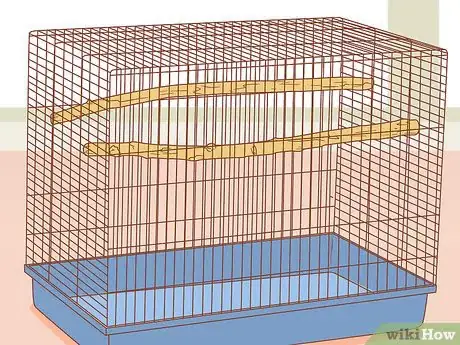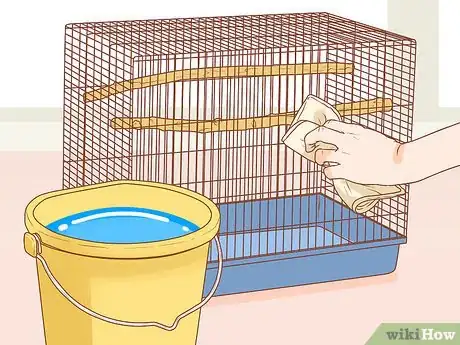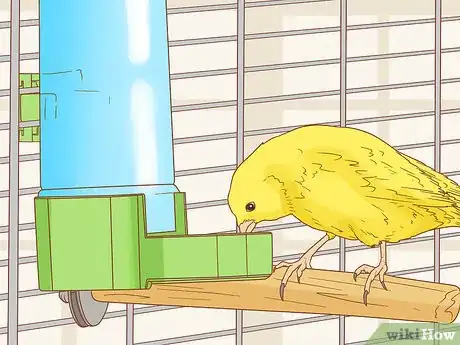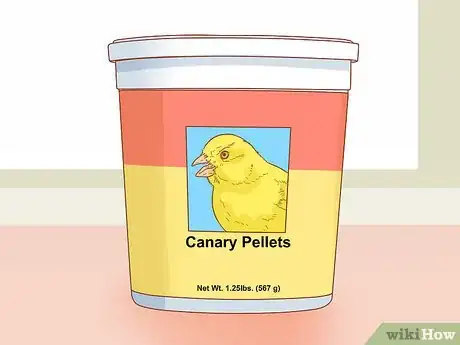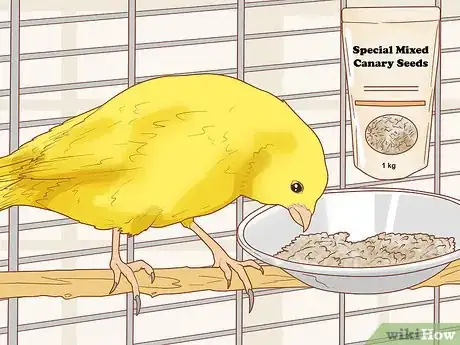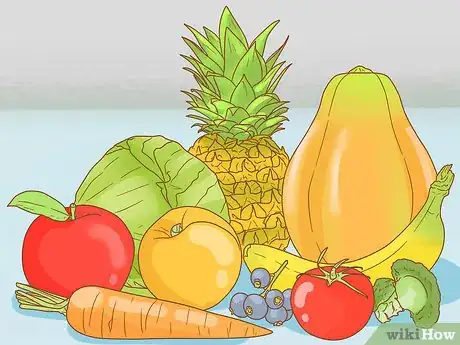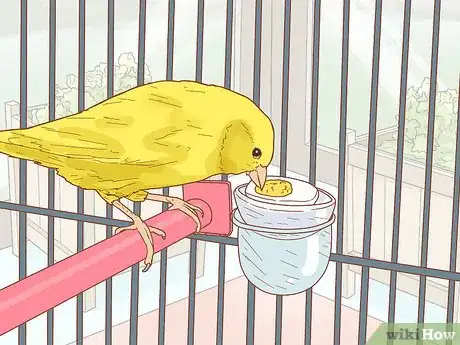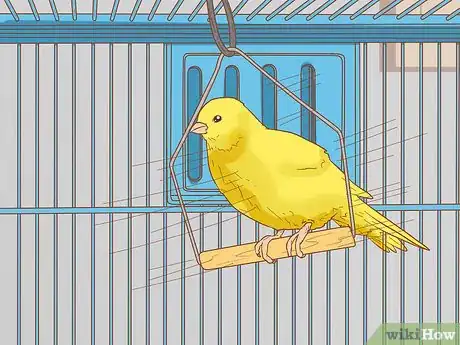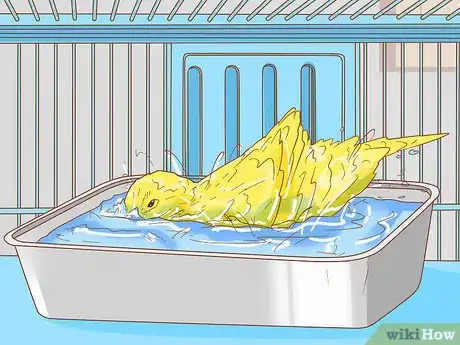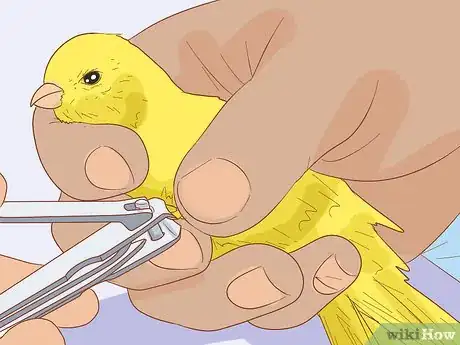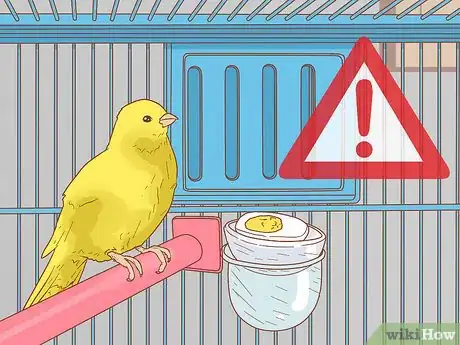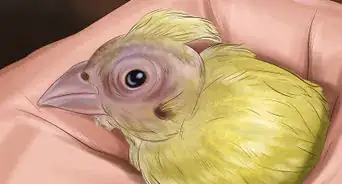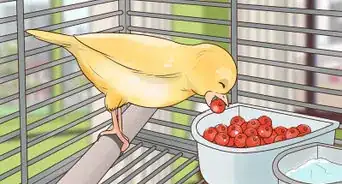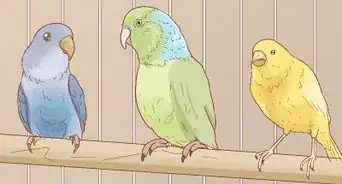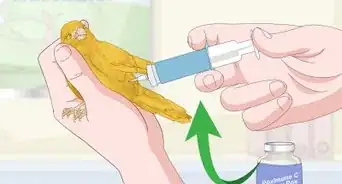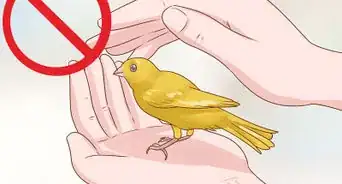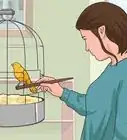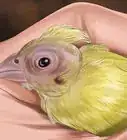This article was co-authored by Pippa Elliott, MRCVS. Dr. Elliott, BVMS, MRCVS is a veterinarian with over 30 years of experience in veterinary surgery and companion animal practice. She graduated from the University of Glasgow in 1987 with a degree in veterinary medicine and surgery. She has worked at the same animal clinic in her hometown for over 20 years.
wikiHow marks an article as reader-approved once it receives enough positive feedback. This article received 14 testimonials and 96% of readers who voted found it helpful, earning it our reader-approved status.
This article has been viewed 203,301 times.
Canaries are a brightly colored, social birds indigenous to the Canary Islands. Sturdy and easy to care for, they regularly live 10-15 years and have been known to live for 20. With a basic knowledge of canary care, you should be able to establish a long relationship with one of these friendly animals.
Steps
Housing Your Canary
-
1Buy a big cage. Canaries like to fly from side to side, making it important that you have a very wide, but not necessarily tall, cage. For one canary your cage should be about 16” tall and 30” wide. The larger the cage, the better for the canary.
- Be sure that the area you put the cage has good light and ventilation, without a draft. It should be away from doors and windows that would allow for direct sunlight, because that might make it too warm. It should be near one wall, to create a greater sense of security for the canary.
- Hang the cage or place it on a stand, so that the cage is elevated approximately 6 feet above the floor.
-
2Install perches. At the pet store, buy natural wood to install along the cage for perches. Buy perches of different diameter to add some diversity to your canary's experience. Because canaries like to fly horizontally, rather than up or down, place the perches on the sides of the cage, across from one another.
- Some canaries also like swings. If you buy one, make sure that this is also off to the side. You do not want it to obstruct your canary's flight across the cage.[1]
Advertisement -
3Clean the cage regularly. Line the bottom of the cage with plain paper, such as butcher's paper. Every day you should replace this paper and clean water and food bowls. Once a week use soap and water or bird cage disinfectant to wash down the entire cage. Avoid using bleach.
- Cleaning the cage is very important. A dirty cage will make your canary susceptible to disease.
Feeding Your Canary
-
1Water regularly. Canaries can die after 24 hours without water. You should have a large water dish in the cage that you refill regularly. Tap water should be good for your canary. However, if you know that your local water standards are poor, consider using bottled water.
-
2Feed your canary pellets. Pellets are a preferred substitute for seeds, because they are designed to include more of the protein and vitamins that your canary needs. However, if your canary was not raised on a pellets, it will likely refuse to eat them. You can try to transition a canary to pellets, but you must do it slowly and carefully.
- If you want to transition your canary to pellets put some in with its seeds and slowly, over a period of 4 to 8 weeks, reduce the quantity of seed and increase the quantity of pellets. If your canary still is not eating the pellets, do not stop feeding it seeds.[2]
-
3Feed your canary seeds. Though they aren't the best source of nutrition for your canary, seeds probably are its favorite type of food. Provide your canary with a seed mix labeled for canaries at the pet store. Feed your canary approximately one teaspoon of food per day. Canaries are not inclined to overeat, so you can feed them slightly more if you believe it is necessary.
-
4Feed your canary fruits and vegetables. About 20 -25% of your canary's daily diet should consist of fruits or vegetables. Every day wash and cut some fruit or vegetables into very small pieces. Place less than a teaspoon in a separate dish. Vary the types of fruit and vegetables you feed your canary frequently.
- Avocado is poisonous to canaries. Lettuce does not offer sufficient nutrition.
- Good fruits and vegetables include: apples, apricots, asparagus, bananas, beat, blueberry, broccoli, Brussel sprouts, cabbage, cantaloupe, carrot, carrot top, coconut, corn, dates, fig, grapes, grapefruit, kale, kiwi, melons, mango, nectarines, orange, papaya, parsnip, peaches, pear, peas, pepper, pineapple, plum, pomegranate, pumpkin, raspberry, spinach, squash, strawberry, sweet potato, tomato, zucchini.[3]
-
5Feed your canary protein. If your canary is on a seed diet it likely is not getting enough protein. A good way to supplement your canary's protein supply is to feed an egg that is boiled for 15-20 minutes. Let it cool down and put small pieces in the treat dish twice per week.
- Egg will go bad quickly. Remove any remaining egg four to five hours after putting it in the cage.
Keeping Your Canary Happy and Healthy
-
1Provide entertainment. A toy or a swing in the cage can help keep your canary entertained. However, canaries are less inclined to play with toys than many other types of birds. One toy should be sufficient. More can clutter up the cage and make it harder for your canary to fly around, which should be your top priority.
- In the wild, canaries like to roll around in damp grass. Putting damp dandelion leaves or grass at the bottom of the cage can serve as a fun distraction.
-
2Give your canary a bath. Your canary should care for itself. You will only need to provide a shallow water dish filled with lukewarm water. Place the dish on the cage floor away from your canary's perch. Plastic planter dishes are ideal. Clean the bowl daily.
-
3Clip your canary's nails. Canary nails need to be clipped approximately twice per year to keep it healthy. However, there is a vein inside the nail that, if punctured, can cause severe and potentially fatal bleeding. Consult with your veterinarian about proper nail clipping technique.[4]EXPERT TIPDr. Elliott, BVMS, MRCVS is a veterinarian with over 30 years of experience in veterinary surgery and companion animal practice. She graduated from the University of Glasgow in 1987 with a degree in veterinary medicine and surgery. She has worked at the same animal clinic in her hometown for over 20 years.Veterinarian

 Pippa Elliott, MRCVS
Pippa Elliott, MRCVS
VeterinarianPippa Elliott, a licensed veterinarian, advises: "Small birds like canaries are easily stressed by nail clipping. Help your bird to cope by getting it used to being handled and touched well before clipping its nails."
-
4Cover your canaries at night. Canaries prefer to sleep in the dark. If there are any outside noises or lights in your house, cover the cage with a towel or blanket over night, to help it go to sleep.
-
5Watch for illness. Canaries are hearty animals. Be aware of signs of illness, however, so that you can take your canary to the vet if anything is wrong. Be mindful if you canary lacks appetite or begins to lose weight rapidly.
- Other signs of illness include droppings that are not black or white, wheezing, lethargy, molting out of season, and ruffled feathers.
- If your canary is fluffed up for long periods of time it might be too cold, and if it holds its wings away from its body and pants, it might be too warm. It will prefer temperatures from 60 to 70 degrees Fahrenheit.
Expert Q&A
Did you know you can get expert answers for this article?
Unlock expert answers by supporting wikiHow
-
QuestionWhat should I do if my canary has diarrhea?
 Pippa Elliott, MRCVSDr. Elliott, BVMS, MRCVS is a veterinarian with over 30 years of experience in veterinary surgery and companion animal practice. She graduated from the University of Glasgow in 1987 with a degree in veterinary medicine and surgery. She has worked at the same animal clinic in her hometown for over 20 years.
Pippa Elliott, MRCVSDr. Elliott, BVMS, MRCVS is a veterinarian with over 30 years of experience in veterinary surgery and companion animal practice. She graduated from the University of Glasgow in 1987 with a degree in veterinary medicine and surgery. She has worked at the same animal clinic in her hometown for over 20 years.
Veterinarian
-
QuestionDo canaries need gravel?
 Pippa Elliott, MRCVSDr. Elliott, BVMS, MRCVS is a veterinarian with over 30 years of experience in veterinary surgery and companion animal practice. She graduated from the University of Glasgow in 1987 with a degree in veterinary medicine and surgery. She has worked at the same animal clinic in her hometown for over 20 years.
Pippa Elliott, MRCVSDr. Elliott, BVMS, MRCVS is a veterinarian with over 30 years of experience in veterinary surgery and companion animal practice. She graduated from the University of Glasgow in 1987 with a degree in veterinary medicine and surgery. She has worked at the same animal clinic in her hometown for over 20 years.
Veterinarian No. Gravel poses an impaction risk in the gut because it is not digestible. Pet canaries have a much better diet than wild birds, and therefore they do not need to grind up the coarse seeds and nuts in the same way that wild birds do. However, it's fine to offer a soluble source of grit, such as cuttlefish or ground-up oyster shell, if you feel happier giving your birds something to help mash up seeds in the gizzard.
No. Gravel poses an impaction risk in the gut because it is not digestible. Pet canaries have a much better diet than wild birds, and therefore they do not need to grind up the coarse seeds and nuts in the same way that wild birds do. However, it's fine to offer a soluble source of grit, such as cuttlefish or ground-up oyster shell, if you feel happier giving your birds something to help mash up seeds in the gizzard.
Things You'll Need
- Bird bath
- High quality birdseed
- Dark leafy greens
- Vitamin supplement
- Bird toys
- Bird swing
- Water dish
- Food bowl
- Bird cage
References
About This Article
To care for your canary, keep it in a roomy cage lined with fresh newspaper and disinfect the cage with soap and water once a week. Provide clean water and seed every day and always rinse out the dishes before refilling them with fresh food and water. Place a separate dish of shallow, lukewarm water in the cage every day so your bird can bathe itself. Finally, cover the cage with a towel or blanket every night to help your canary sleep. For tips on providing entertainment for your canary, read on!

